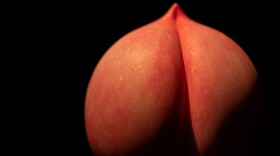If you're driving through Connecticut, you've probably noticed a lot of colors on your commute. Fall foliage has been on full display these last few weeks, with reds, oranges, and yellows covering trees all over New England. You may even have spent your weekend raking leaves up. But have you ever stopped to consider why leaves change color? Or how they fall off trees?
For a leaf, there's one main job: making food. If you paid attention in high school biology, you may even remember the name for this process -- photosynthesis.
At the heart of that process is one green pigment called chlorophyll. During the spring and summer, it's by far the dominant pigment in a leaf and that's why leaves are green. But in the fall -- chlorophyll starts to disappear.
To understand why, I spoke with Jenica Allen, assistant professor in residence at UConn. She told me that as temperatures drop, leaves get flooded with hormonal signals telling them to cease chlorophyll production. Chlorophyll contains a lot of nitrogen, which can be difficult for plants to get. So when winter comes, a tree wants reclaim as much of it as possible and the pigment starts to break down.
"They don't want to dump the nitrogen back on the ground and have to wait for it to get recycled into the soil so they can take it up again," Allen said. "They'd rather break it down -- pull it back into the core parts of the tree, and then be able to push it back out to the branches and into new leaves in the spring."
Now that all that green chlorophyll is gone, Allen said two other pigments in the leaf get a chance to show their quality: carotenoid and anthocyanin.

Carotenoids are the same pigment you find in egg yolks and carrots. They responsible for the yellows and oranges you see in a leaf. Anthocyanin is a pigment that's produced during the fall and gives leaves their red hues.
"And so it's the combination of the carotenoids that are left, which are the oranges and yellows -- and then the production of those red pigments -- the combination of that determines what color we see in the fall," Allen said.

But what about the inevitable dropping of the leaves that gives “fall” its name? Ever wondered exactly how a leaf falls? Well, look no further than abscission cells -- tiny little messengers which tell the leaf, "Sorry, but I'm just not that into you anymore."
"And essentially abscission as the same root as scissor - so that's where the leaf is going to be cut off the plant," Allen said.
During fall, a cellular separation zone forms between the leaf and the tree. It's important to note that abscission is a two-part process that simultaneously weakens the leaf's grip, while cells actively push the leaf off the branch.
"When trees lose their leaves it an active process. Other passive forces like wind and heavy rain can contribute to that. But the trees are definitely saying, 'Get out the door.' They don't need those tissues in the winter, and if they have them it's actually a liability," Allen said.
That liability was on full display when maple trees took heavy damage during recent ice storms in Connecticut.
Overall, Allen said leaf coloration in Connecticut has been pretty good this fall, but if you haven't gotten out there yet, do it soon. Connecticut just had its first hard frost. That means all the chemistry we just talked about will stop and that leaves will lose their color very quickly.





